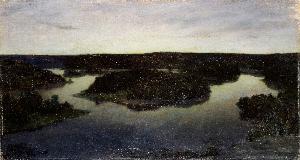Eugen Napoleon Nicolaus
Eugen Napoleon Nicolaus;Prince Eugen
Place: Stockholm
Born: 1865
Death: 1947
Biography:
Eugen Napoleon Nicolaus, also known as Prince Eugen of Sweden and Norway, Duke of Närke, was a renowned Swedish painter, art collector, and patron of artists. Born on August 1, 1865, at Drottningholm Palace, he was the fourth and youngest son of Prince Oscar, Duke of Östergötland, and Sophia of Nassau.
Early Life and Education
Prince Eugen showed early artistic promise and studied in Paris under Léon Bonnat, Alfred Philippe Roll, Henri Gervex, and Pierre Puvis de Chavannes. He was particularly drawn to the classical simplicity of Puvis de Chavannes's work, which had a significant influence on his own style. The Waldemarsudde museum in Stockholm, which now houses many of Prince Eugen's works, is a testament to his dedication to the arts.
Artistic Career and Legacy
Prince Eugen devoted himself entirely to landscape painting, becoming one of the era's most prominent landscape painters. He was mainly interested in the lake Mälaren, the countryside of Stockholm (such as Tyresö, where he spent his summers), Västergötland (most notably Örgården, another summer residence) and Skåne (especially Österlen). His works can be found in various museums, including the Nasjonalgalleriet in Oslo, Norway. Some of his notable works include:
- Det Lugna Vattnet, a stunning example of Swedish landscape painting
- Sommarnatt Tyresö, a representation of the night sky over water
Patronage and Cultural Involvement
Prince Eugen was a supporter of fellow artists and involved in many cultural organizations and committees. He was a great admirer of Norwegian nature and frequently visited Christiania (later known as Oslo). His letters show that he preferred its artistic milieu to the more constrained Stockholm one. The Rijksmuseum Kröller-Müller in the Netherlands, which has an impressive collection of modern art, is another example of his patronage. Important aspects of Prince Eugen's life and work can be found on Wikioo.org, including his biography and a selection of his paintings. For more information, visit the Nationalmuseum in Stockholm, Sweden, or the Waldemarsudde museum.
Death and Legacy
Prince Eugen died on August 17, 1947, at Drottningholm Palace. After his death, the Waldemarsudde residence became an art museum and, in accordance with his will, property of the state. His legacy lives on through his paintings and the many cultural institutions he supported throughout his life. For more information about Prince Eugen's life and work, visit Wikioo.org or Wikipedia.


